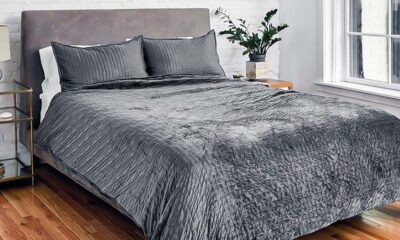Science
Astronomers Unveil High-Resolution Spectra of Beta Pictoris b

Astronomers have achieved a significant milestone in exoplanet research with the first high-resolution observations of the exoplanet β Pictoris b, utilizing the Very Large Telescope Interferometer (VLTI) and its GRAVITY instrument. These observations, conducted at a resolution of R λ ∼4000, reveal four K-band spectra that maintain both the pseudo-continuum and molecular absorption features critical for analysis.
Using these spectra, researchers explored various parameters such as effective temperature, surface gravity, metallicity, carbon-to-oxygen ratio, and the ratio of isotopes 12CO to 13CO. The analysis involved comparing the data against four self-consistent forward model grids: Exo-REM, ATMO, BT-Settl, and Sonora. This comprehensive approach allowed for a deeper understanding of the atmospheric conditions surrounding the exoplanet.
The results indicate that models incorporating Exo-REM are statistically favored. From the observations, the effective temperature of β Pictoris b was determined to be approximately 1607.45 K, with a surface gravity of 4.46 dex based solely on GRAVITY data. When integrating all datasets, the effective temperature slightly decreased to 1502.74 K while the gravity remained stable at 4.00 dex.
The analysis revealed that the carbon-to-oxygen ratio remains solar at approximately 0.552, while the metallicity reached super-solar values at 0.50. This finding is significant as it may provide insights into the formation and evolution of β Pictoris b and its surrounding environment. The study also reports a preliminary constraint on the isotopic ratio of 12CO/13CO, estimated at around 1.12, though this remains inconclusive due to residual atmospheric interference.
The luminosity of β Pictoris b was estimated to be -4.01, suggesting a heavy-element content of up to 5%, which translates to a mass range between 20 and 80 Earth masses considering the system’s age and dynamical mass. The study emphasizes that access to both continuum and molecular lines at K-band plays a crucial role in determining metallicity, likely influenced by collision-induced absorption.
Future research frameworks should consider incorporating weighting schemes that reflect bandwidth and central wavelength coverage to improve the accuracy of atmospheric characterizations. The findings from this study are slated for publication in Astronomy & Astrophysics and were accepted on September 29, 2025.
This research not only advances our understanding of β Pictoris b but also sets a precedent for future studies of exoplanet atmospheres, highlighting the importance of high-resolution spectra in deciphering the complex characteristics of distant worlds.
-

 Technology5 months ago
Technology5 months agoDiscover the Top 10 Calorie Counting Apps of 2025
-

 Health2 months ago
Health2 months agoBella Hadid Shares Health Update After Treatment for Lyme Disease
-

 Health3 months ago
Health3 months agoErin Bates Shares Recovery Update Following Sepsis Complications
-

 Technology4 months ago
Technology4 months agoDiscover How to Reverse Image Search Using ChatGPT Effortlessly
-

 Technology1 month ago
Technology1 month agoDiscover 2025’s Top GPUs for Exceptional 4K Gaming Performance
-

 Technology2 months ago
Technology2 months agoElectric Moto Influencer Surronster Arrested in Tijuana
-

 Technology5 months ago
Technology5 months agoMeta Initiates $60B AI Data Center Expansion, Starting in Ohio
-

 Technology5 months ago
Technology5 months agoRecovering a Suspended TikTok Account: A Step-by-Step Guide
-

 Health4 months ago
Health4 months agoTested: Rab Firewall Mountain Jacket Survives Harsh Conditions
-

 Lifestyle5 months ago
Lifestyle5 months agoBelton Family Reunites After Daughter Survives Hill Country Floods
-

 Technology4 months ago
Technology4 months agoHarmonic Launches AI Chatbot App to Transform Mathematical Reasoning
-

 Technology3 months ago
Technology3 months agoUncovering the Top Five Most Challenging Motorcycles to Ride





















